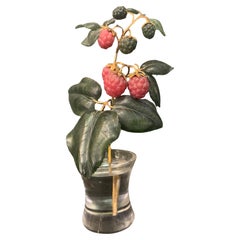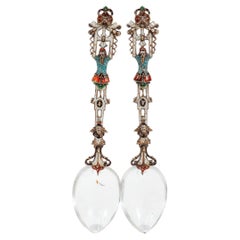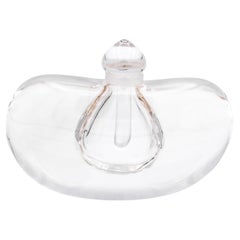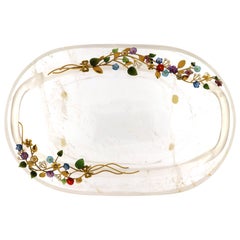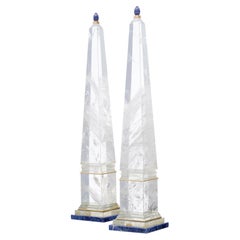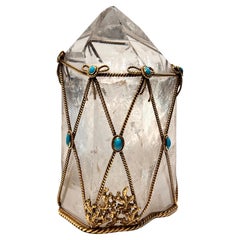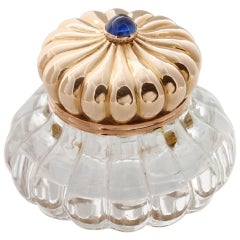Rock Crystal Objets d'Art and Vertu
1670s Danish Baroque Antique Rock Crystal Objets d'Art and Vertu
Crystal, Rock Crystal, Silver
1980s Contemporary Vintage Rock Crystal Objets d'Art and Vertu
Rock Crystal
1980s French Art Deco Vintage Rock Crystal Objets d'Art and Vertu
Diamond, Rock Crystal, 18k Gold, Silver
20th Century French Rock Crystal Objets d'Art and Vertu
Crystal, Rock Crystal, 18k Gold
1960s American Vintage Rock Crystal Objets d'Art and Vertu
Rock Crystal, Turquoise, 18k Gold
Late 19th Century Russian Victorian Antique Rock Crystal Objets d'Art and Vertu
Rock Crystal, Blue Sapphire, Gold
1980s Unknown Vintage Rock Crystal Objets d'Art and Vertu
Quartz, Rock Crystal, Crystal, Gold
1980s French Retro Vintage Rock Crystal Objets d'Art and Vertu
Agate, Rock Crystal
1980s Unknown Vintage Rock Crystal Objets d'Art and Vertu
Rock Crystal, Gold, 18k Gold
21st Century and Contemporary French Rock Crystal Objets d'Art and Vertu
Diamond, Lapis Lazuli, Rock Crystal, Gold, Silver
20th Century French Rock Crystal Objets d'Art and Vertu
Chalcedony, Coral, Rock Crystal, 18k Gold
18th Century Indian Antique Rock Crystal Objets d'Art and Vertu
Rock Crystal, Gold
1970s French Vintage Rock Crystal Objets d'Art and Vertu
Amethyst, Carnelian, Onyx, Rock Crystal, Gold, 18k Gold, Yellow Gold
Late 19th Century Russian Victorian Antique Rock Crystal Objets d'Art and Vertu
Diamond, Rock Crystal, Silver, Enamel
20th Century French Art Deco Rock Crystal Objets d'Art and Vertu
Agate, Diamond, Emerald, Rock Crystal, Gold, Silver
20th Century Rock Crystal Objets d'Art and Vertu
Agate, Rock Crystal, 14k Gold
20th Century Retro Rock Crystal Objets d'Art and Vertu
Crystal, Diamond, Rock Crystal, 18k Gold, Enamel
Mid-19th Century Antique Rock Crystal Objets d'Art and Vertu
Diamond, Rock Crystal, Crystal, 18k Gold
20th Century French Rock Crystal Objets d'Art and Vertu
Amethyst, Diamond, Jade, Quartz, Rock Crystal, Ruby, Turquoise, Gold, Si...
Early 2000s Indian Art Deco Rock Crystal Objets d'Art and Vertu
Crystal, Rock Crystal, Ruby, Gold
20th Century Unknown Rock Crystal Objets d'Art and Vertu
Crystal, Rock Crystal, Lapis Lazuli, Ruby, Silver
1970s French Vintage Rock Crystal Objets d'Art and Vertu
Crystal, Rock Crystal, 18k Gold
1980s Unknown Vintage Rock Crystal Objets d'Art and Vertu
Rock Crystal, Yellow Gold
20th Century Italian Art Deco Rock Crystal Objets d'Art and Vertu
Rock Crystal, Diamond, Silver
2010s Italian Rock Crystal Objets d'Art and Vertu
Rock Crystal, Sterling Silver
20th Century French Art Deco Rock Crystal Objets d'Art and Vertu
Rock Crystal, Ruby, Blue Sapphire, Silver
Late 19th Century Russian Art Nouveau Antique Rock Crystal Objets d'Art and Vertu
Rock Crystal, Bronze
Early 2000s Indian Art Deco Rock Crystal Objets d'Art and Vertu
Crystal, Rock Crystal, Ruby, Gold
19th Century Austrian Renaissance Revival Antique Rock Crystal Objets d'Art and Vertu
Rock Crystal, Silver, Enamel
Late 19th Century Austrian Baroque Revival Antique Rock Crystal Objets d'Art and Vertu
Crystal, Rock Crystal, Silver, Enamel
Late 20th Century American Rock Crystal Objets d'Art and Vertu
Crystal, Rock Crystal
1990s Asian Rock Crystal Objets d'Art and Vertu
Amethyst, Jade, Pearl, Rock Crystal, Yellow Gold
19th Century French Antique Rock Crystal Objets d'Art and Vertu
Carnelian, Crystal, Rock Crystal, Gold, 18k Gold, Yellow Gold, Enamel
2010s Indian Rock Crystal Objets d'Art and Vertu
Amethyst, Citrine, Quartz, Rock Crystal, Blue Topaz, 22k Gold
1980s Unknown Vintage Rock Crystal Objets d'Art and Vertu
Amethyst, Crystal, Rock Crystal, Diamond, Gold, 18k Gold
Read More
How to Identify Real Capodimonte Porcelain
Early examples by the Italian manufacturer can be hard to come by, but the best later pieces possess the same over-the-top charm.
Ask an Interior Designer: Work-from-Home Edition
Leaping into a design project, whether it's refreshing the bedroom or redoing the whole house, can be overwhelming. Luckily, we know more than a few interior designers. You asked questions on Instagram, and now they're answering.
